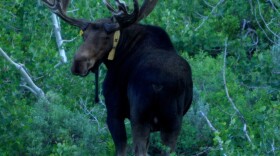Southern Nevada is famous for regularly tearing down its history, but that’s not true for all corners of the valley. As you learn in this episode of Vegas PBS’s “Outdoor Nevada,” the natural history that encouraged people to settle in the area is well preserved. Whether it’s Ice Age Fossils State Park’s window into the prehistoric past, or the wildlife-laden springs near Pioche that feed Spring Valley and Echo Canyon State Parks, there’s something to appreciate in all of Nevada’s 27 state parks.
For an occasional small fee, park-goers can camp, hike, learn, picnic, mountain bike, climb, bird, fish, and much more. At Ice Age Fossils State Park on the northern edge of Las Vegas, “Outdoor Nevada” host Connor Fields describes the area once home to megafauna and other ancient critters, with some fossils dating back to 90,000 years ago. Near Pioche, Fields appreciated the stunning hikes and access to wildlife.
“There was another thing I noticed while I was here: the birds,” Fields says. “Echo Canyon and Spring Valley State Parks are home to a variety of different bird species, including ducks, herons and songbirds, especially around the reservoir area. It feels like a bird watcher's paradise. I even spotted a raptor soaring above the park's cliffs. It's always fun to see different types of wildlife. And the variety of birds here is amazing.”
Las Vegas is home to two other state parks: Old Las Vegas Mormon Fort and Spring Mountain Ranch. (Valley of Fire is also nearby, located about an hour from downtown.) For a gorgeous hike in this bustling urban area, head to Spring Mountain Ranch in the Rainbow Mountain Wilderness.
The ranch was settled around the 1830s, and a pair of investors bought it in 1976, building a blacksmith shop and a cabin — which remain among Nevada’s oldest buildings — on the property. Over the years, German film star Vera Krupp and business magnate Howard Hughes owned the ranch, before it became a state park in 1973.
The park offers several short hiking trails, the longest of which is the Sandstone Canyon Loop at 1.2 miles. It takes you back toward the mountains and along several water features, including the manmade Lake Harriet, home to the endangered Pahrump pool fish. This is a fantastic beginner trail, with a very low grade and few rocky sections. The lush canyon is unlike most of the surrounding area and full of wildlife.
Getting there: From downtown Las Vegas, take Charleston Boulevard west toward Red Rock Canyon, but continue down State Route 159 until you’ve passed the three main trailheads (Middle Oak Creek, South Oak Creek, First Creek). The entrance will be on the right. If you hit the town of Blue Diamond, you’ve gone too far.
Pro tip: Try the passport challenge! You can pick up a Nevada State Parks Passport booklet at any state park for free. Visitors who collect 15 stamps will earn a free annual pass to the parks. Also, while paying entrance fees helps support our public lands, the state park system expanded accessibility in 2023 by offering day-use passes through public libraries. Check out the pass at your local library for up to a week to waive the entrance fee for one vehicle with up to eight people.
Bonus tip: The park is about 10 degrees cooler than Las Vegas — something to consider when the temps start warming up again.









